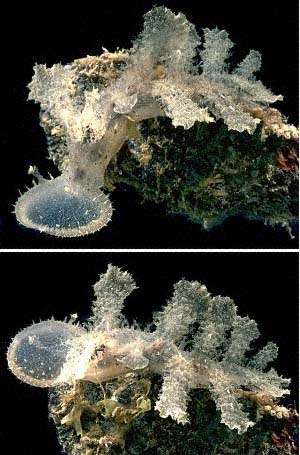
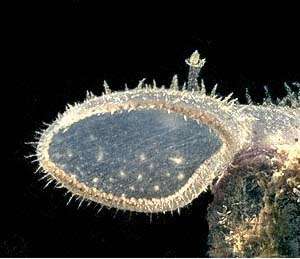
Melibe viridis
Kelaart, 1858
Order: NUDIBRANCHIA
Suborder: DENDRONOTINA
Family: Tethydidae
DISTRIBUTION
Tropical Indo-West Pacific.
PHOTO
Koumac, northern New Caledonia, in grass beds, 80mm long alive. October 1993. UPPER photo showing "net-like" oral veil stretched out feeling for crustacean prey. LOWER photo showing ventral side of oral veil showing rows of sensory papillae around inner edge of veil which can rapidly close when prey is detected.
PHOTOS: Bill Rudman.
There are a number of benthic species of Melibe in the tropical Indo-West Pacific. Melibe viridis can grow to over 120mm in length. Their most unique attribute is their method of feeding. They have lost their radular teeth and have developed the oral veil into a large veil or "fish net" which they use to constantly scan the substrate as they crawl along. When the sensitive papillae on the inner edge of the oral veil touch a small crab or crustacean the edge of the veil is rapidly contracted, trapping the prey, which is then ingested. Some species of Melibe, but not this species, harbour zooxanthellae in their bodies.
The genus Melibe was reviewed by Gosliner, (1987) but the identity of at least two of the larger species, Melibe pilosa Pease, 1860 (from Hawaii) and Melibe fimbriata Alder & Hancock, 1864, (from India) is not resolved. A third species, Meliboea viridis Kelaart, 1858, originally described from Ceylon, has been ignored by all subsequent authors, except Alder & Hancock (1864), who considered it to be most probably, a juvenile of their M. fimbriata.
I use Kelaart's name as I can find no consistent differences to justify the separation of these two species. That is not to say that there are not other species of Melibe in the Indo-West Pacific.
Note added 14 January 2004: This species, or one of this species complex, has migrated through the Suez Canal into the Mediterranean where it is usually identified as Melibe fimbriata. Until the taxonomic problems mentioned above are resolved, records from the Mediterranean have been moved to a separate Melibe fimbriata Page.
Reference:
• Gosliner, T.M. (1987) Review of the nudibranch genus Melibe with description of two new species. The Veliger, 29: 400-414.
Rudman, W.B., 1999 (January 7) Melibe viridis Kelaart, 1858. [In] Sea Slug Forum. Australian Museum, Sydney. Available from http://www.seaslugforum.net/find/meliviri
Related messages
Melibe viridis from South Africa
November 20, 2009
From: Valda Fraser

Dear Bill
The first Melibe I have ever seen and now I'm a BIG fan.
They drove me crazy ... trying to get an image that looks better than a blob with processes.
There were numerous individuals of different sizes and colouration. They were feeding on the grass beds in the estuary. I love they way they "comb" the leaves with their enormous mouths. What are they eating?
I have included an image of one guarding its egg mass. Please help with ID details.
Locality: Pomene, 2 m, Mozambique, Indian, 15 November 2009, Grass beds in estuary. Length: 8 cm - 20 cm. Photographer: Valda Fraser.
Take care
Valda
valdafraser@mweb.co.za

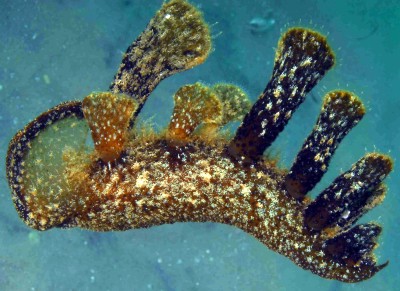
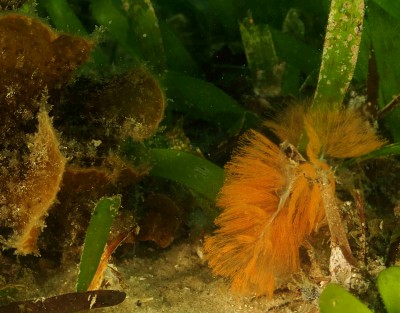
Dear Valda,
As you will see from earlier discussions I am of the opinion that the name Melibe viridis applies to this large species which is wide spread in the Indo-East Pacific.
As to what they eat. Have look at some of the other species and accompanying messages. They feed on small crustaceans [ shrimps, amphipods etc] and I have fed them small crabs in captivity. They catch these in their huge oral hood which acts like a fisherman's hand net or dip net but is more 'high tech' because it has all the sensory feelers along the edge of the opening to find suitable prey. By wiping along all the blades of sea grass it makes little crustacea try and escape by swimming into the 'net' where they are swallowed.
I don't think that anyone who has seen these animals in action could be anything but a very big fan!
Best wishes,
Bill Rudman
Re: Melibe viridis in East Timor
November 20, 2009
From: Brian Francisco
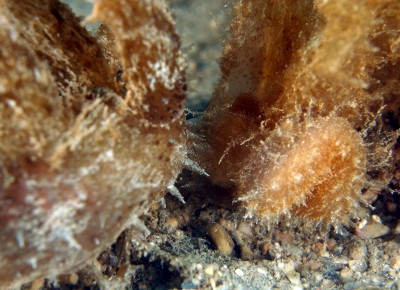
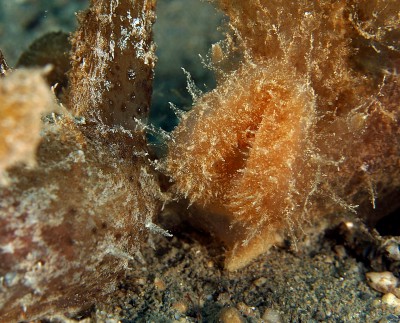
Concerning message #17451:
Hi Bill
I thought I'd share a few shots I took this morning of two Melibe (viridis?) mating. As I coaxed the two individuals apart it was quite easy to make out a star-shaped opening on their right sides (pic 3). The small appendages that comprised this star-shaped opening seemed to extend out in search of the partner and reconnected very quickly.
Locality: Tasi Tolu, 18 meters, East Timor, Banda Sea, 01 November 2008, sandy slope. Length: 10 cm. Photographer: Brian Francisco.
We saw 6 or 7 individuals this morning, but no egg ribbons.
Regards
Brian
francisco.brian@gmail.com
Francisco, B., 2009 (Nov 20) Re: Melibe viridis in East Timor. [Message in] Sea Slug Forum. Australian Museum, Sydney. Available from http://www.seaslugforum.net/find/22009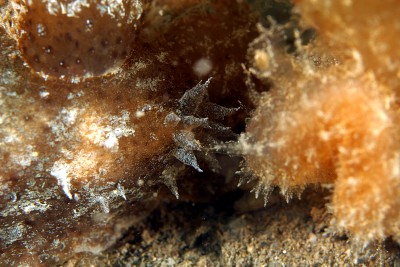
Dear Brian,
There could well be a ring of papillae like we can see in your lower photo, around the genital opening of the darker animal on the left. Just to make it clear to other readers, what you can see in the lighter brown animal on the right is its head and oral hood. I assume when Brian coaxed them apart, the right animal started moving around.
Best wishes,
Bill Rudman
Melibe viridis from Singapore
October 31, 2008
From: Toh Chay Hoon

Dear Dr Bill,
Here are photos of two Melibe viridis taken from another submerged patch reef south of Singapore.
They were found near Bryopsis algae among Seagrasses and coral rubbles.
Locality: Cyrene Reef, intertidal, Singapore, South China Sea, 8 May 2008, Intertidal. Length: 50-120 mm. Photographer: Toh Chay Hoon.
Thank you,
Chay Hoon
sonnenflower@gmail.com
Toh C.H., 2008 (Oct 31) Melibe viridis from Singapore. [Message in] Sea Slug Forum. Australian Museum, Sydney. Available from http://www.seaslugforum.net/find/21998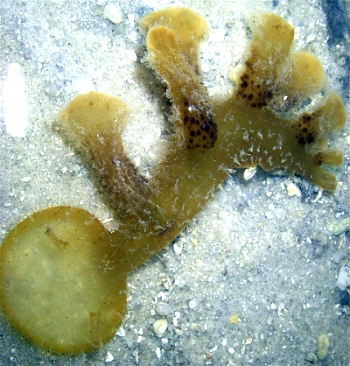
Thanks Chay Hoon,
Best wishes,
Bill Rudman
Is this a Melibe?
October 27, 2008
From: Ron Yeo
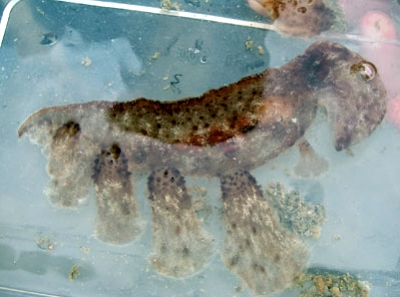
Dear Bill,
We found this next to a rock in a coral rubble area during low tide. Thought it looks like a Melibe.
Locality: Semakau Landfill, Singapore, Singapore, Straits of Singapore, 3 December 2006, Intertidal. Length: 10 cm. Photographer: Ron Yeo.
Will really appreciate it if you can assist to identify it.
Thanks,
Ron Yeo
ronyeo@gmail.com
Yeo, R, 2008 (Oct 27) Is this a Melibe?. [Message in] Sea Slug Forum. Australian Museum, Sydney. Available from http://www.seaslugforum.net/find/18999Dear Ron,
Yes this is Melibe viridis.
Best wishes,
Bill Rudman
Melibe viridis from Lembeh Straits
October 24, 2008
From: Mark Atwell
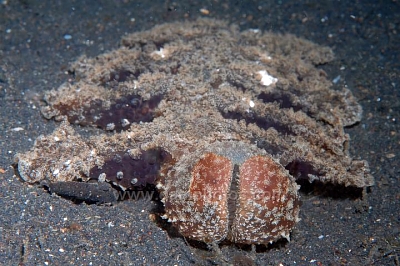
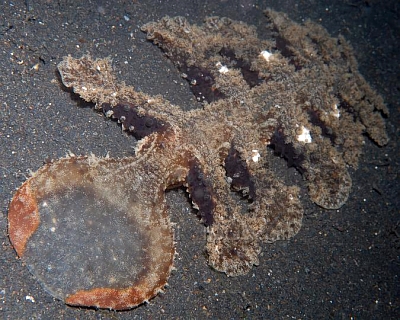
Concerning message #19192:
An apparently large (~30 cm) specimen of Melibe viridis - note the Imperator shrimp [Periclimenes imperator ] on the side of its 'neck' in one of the pictures.
Locality: Dive Site 'TK3', Lembeh Straits, Circa 15 metres, Sulewesi, Lembeh Straits, 23 April 2006, Classic Lembeh Straits - muddy, volcanic. Length: 30 cm. Photographer: Mark Atwell.
Mark Atwell
mark.atwell@gmail.com
Mark Atwell, 2008 (Oct 24) Melibe viridis from Lembeh Straits. [Message in] Sea Slug Forum. Australian Museum, Sydney. Available from http://www.seaslugforum.net/find/20064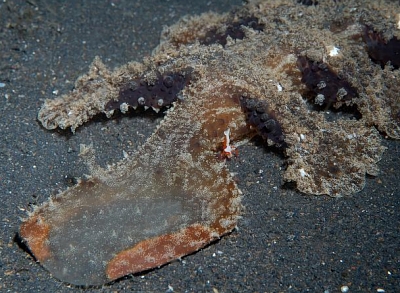
Dear Mark,
Thanks for these photos. Like other specimens from that region [see messages #3026, #12461], these animals seem a lot darker than the yellow brown background colour we normally expect. Perhaps it is connected with the dark grey-black background colour of the substrate?
Best wishes,
Bill Rudman
Melibe sp. from Thailand
October 24, 2008
From: Lawrence Neal

Concerning message #21985:
Dear Bill,
Just to continue with the Melibe mirifica, M. japonica, M. viridis saga, here is a specimen photographed in the northern Gulf of Thailand, found on a flat plain of mixed sand and sediment in a sheltered bay, about 10 metres deep. This one is what I would call perhaps 'champagne' coloured but we occasionally come across darker specimens more the colour of 'cognac'. They are well camouflaged and don't offer much contrast in photographs. I noticed that when there's a current running they seem to find a depression in the sand and flatten themselves into it, looking just like a blob of jelly. When they're on the move, they exhibit the characteristic 'oral veil casting' feeding pattern.
Locality: Haad Nual, Koh Larn, 10 metres, Chonburi province, Thailand, Gulf of Thailand, 25 February 2007, Sheltered sandy bay. Length: 200 mm. Photographer: Lawrence Neal.
Incidentally, this divesite is just a few miles west from Chantaburi province in Thailand where Bergh collected his type specimen of Melibe bucephala in 1900, so you might like to add this species name to the problematic three mentioned above.
All the best,
Lawrence
lorenzo_n@yahoo.com
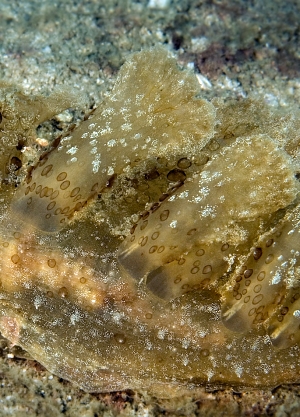

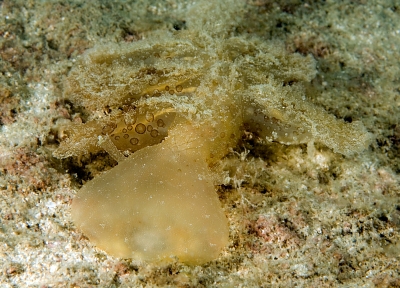
Dear Lawrence,
Thanks for this message. The recent M. japonica - M. mirifica conversation you mention has caused me to re-read Gosliner & Smith's (2003) revision of the genus.
Of the species we are discussing, they consider M. viridis and M. bucephala to be distinct species, but consider M. mirifica to be a probable synonym of M. viridis. They also consider M. japonica to be unidentifiable, but most likely to be another synonym of M. viridis. As I discussed before [message #21985] Allan's description of M. mirifica can be matched with the recently found animals in Queensland, and also to the species in Japan that Japanese workers have identified with M. japonica. If so, it is certanly not a synonym of M. viridis.
Considering Gosliner & Smith consider the original descriptions of M. mirifica and M. japonica to be inadequate, I am surprised they feel able to recognise M. bucephala which was described, also poorly, from one damaged, preserved specimen, As Kathe Jensen notes [#13409], the holotype consists now of an empty carcase, so its anatomy cannot be revisited. Bergh's only comment on the living colour was that it was brown. Gosliner & Smith base their review of its anatomy on a single preserved specimen from the Suez Canal identified by O'Donoghue (1929). There is no way of knowing if this animal was conspecific with Berh's M. bucephala, and O'Donoghue's note that an accompanying colour sketch showed that the papillae has irregular white spots, and some rounded projections on the outer side [of the body] are a deep red, could well fit what I am calling M. viridis.
Which brings me to your animals. I would consider them to be large M. viridis. Gosliner & Smith consider that species is the only one with tubercles and papillae on the dorsum and the cerata, as your animals clearly have. That would also mean that the animals I have recently placed as Melibe cf. mirifica are M. viridis as well [#21985 ]. That certainly clarifies that little puzzle. Any comments welcome.
Best wishes,
Bill Rudman
Re: Melibe viridis laying eggs
June 11, 2008
From: Teresa Zuberbühler
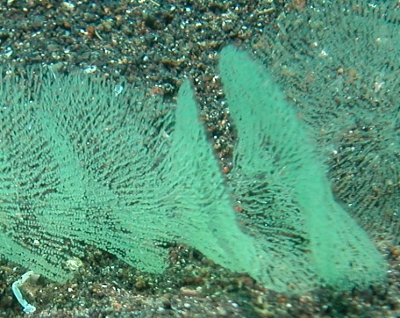
Concerning message #21620:
Dear Bill
I had to look up the word "dextrally" in my dictionary ("rechthändig" in German..), then I went and took a closer look at some more of my photos and I think these egg ribbons are dextrally.
Locality: Lembeh, 12-15 m, Sulawesi, Indonesia, Pacific, 4. Juli 2006, black sand. Photographer: Teresa (Zubi) Zuberbühler.
I add some close-ups.
Teresa
webmaster@starfish.ch
Zuberbühler, T., 2008 (Jun 11) Re: Melibe viridis laying eggs. [Message in] Sea Slug Forum. Australian Museum, Sydney. Available from http://www.seaslugforum.net/find/21629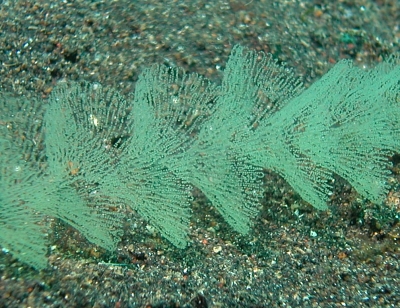
Dear Zubi,
Thanks for the extra photos. Yes it means a right-handed (clockwise) spiral, but I am afraid the transparency of the ribbon makes its impossible for me to decide from these photos - perhaps if you had the free end of the ribbon it would be easier to see?
Best wishes,
Bill Rudman
Re: Melibe viridis - edge of the oral hood
June 6, 2008
From: Teresa Zuberbühler
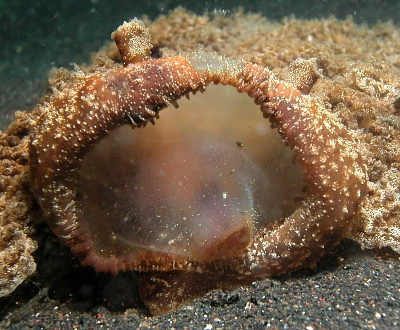
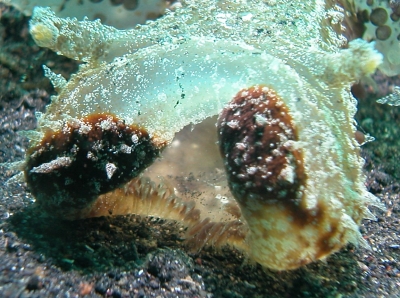
Concerning message #21620:
Dear Bill
Here are the photos of the sensory papillae around the edge of the oral hood of Melibe. On one photo I think you can also see the extending oral tube.
Locality: Lembeh, 12-15 m, Sulawesi, Indonesia, Pacific, 16. March 2005 and 7. July 2006, black sand. Photographer: Teresa (Zubi) Zuberbühler.
Best wishes
Teresa Zubi
webmaster@starfish.ch
Zuberbühler, T., 2008 (Jun 6) Re: Melibe viridis - edge of the oral hood. [Message in] Sea Slug Forum. Australian Museum, Sydney. Available from http://www.seaslugforum.net/find/21628
Dear Zubi,
Thanks very much for your fast response. In the upper photo you can clearly see an extended cone-shaped oral tube (with the mouth at its tip). I have only seen this happen before when the edge of the oral hood was flat on the ground. So this is the first clear view I have had of it.
Best wishes,
Bill Rudman
Melibe viridis laying eggs
June 5, 2008
From: Teresa Zuberbühler
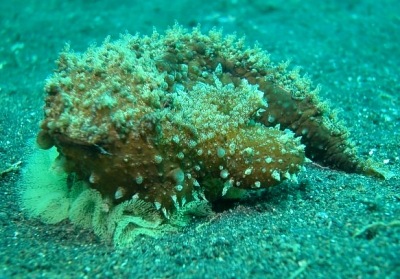
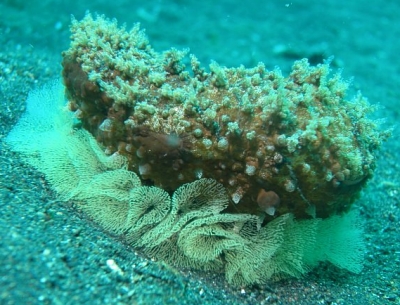
Concerning message #21110:
Dear Bill
I send you some pictures of Melibe viridis laying eggs. I saw you already have a picture (message #13244 ) of the egg ribbon, on my photos you see the animal actually extruding it.
I have been diving in Lembeh over several years, but had never seen the eggs of Melibe. Then in 2006 we saw the egg-ribbons laying around at several dive sites and also chanced apon a Melibe laying the eggs.
Locality: Lembeh, 12-15m, Sulawesi, Indonesia, Pacific, 4. Juli 2006, black sand. Length: 8 cm?. Photographer: Teresa (Zubi) Zuberbühler.
A fascinating slug!! I love to see them feeding - the great maw with the teethlike rows of sensory papillae (would you like a close-up shot of those "teeth"?). What is also interesting are the small Periclimenes imperator shrimps, that often perch on them, sometimes 3 or more on one nudibranch.
Greetings
Teresa Zubi
www.starfish.ch
webmaster@starfish.ch
Zuberbühler, T., 2008 (Jun 5) Melibe viridis laying eggs. [Message in] Sea Slug Forum. Australian Museum, Sydney. Available from http://www.seaslugforum.net/find/21620
Dear Teresa or Zubi,
This is a fascinating animal, and yes, I would like to add a photo showing the sensory papillae around the edge of the oral hood. We used to think of Periclimenes imperator as an associate of Hexabranchus sanguineus, but it has been found with many different - usually large - opisthobranchs, so the association is not as specific as first thought. Shrimps living on a shrimp-eater seems a rather foolhardy exercise, but I guess natural seletion will ensure the shrimps are good at escaping the oral hood.
In an earlier message [#9356] message I discuss how two species of Melibe seem to have a dextrally spiralling egg ribbon so I was curious to see which way the egg ribbon coiled in your photo. I am not 100% convinced I can work out the direction of coiling from the photos, but it seems to be dextral as well, which would suggest that the direction of coiling in this case may be at least a generic characteristic, which would be very interesting.
Best wishes,
Bill Rudman
Sea slug with paddles?
November 30, 2007
From: Annabelle Sandes
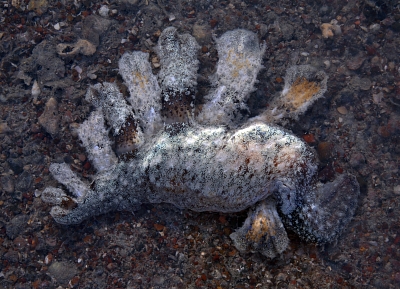
Hello Bill,
This slug was found on a gravelly sand substrate on a sandbank in Deception Bay on the mid North Kimberley Coast, Western Australia, exposed on a low spring tide. At high tide, the sandbank is 10 m underwater. The animal was wriggling around and was one of two found on the extensive sandbank.
Size was approximately 15 cm.
Locality: Sandbank, Deception Bay, 10 m, Western Australia, Indian Ocean, 1 September 2007, sandbank. Length: 15 cm. Photographer: Annabelle Sandes.
Please help me to identify it.
Kind regards,
Annabelle Sandes
dingoprincess@bigpond.com
Sandes, L. A., 2007 (Nov 30) Sea slug with paddles?. [Message in] Sea Slug Forum. Australian Museum, Sydney. Available from http://www.seaslugforum.net/find/21110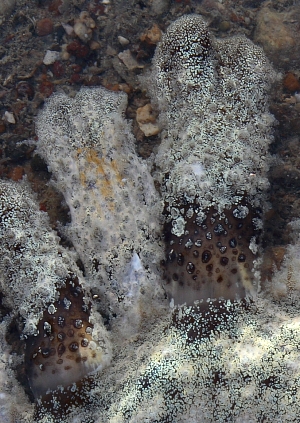
Dear Annabelle,
A 'sea slug with paddles' is quite a good description of this animal, but if you saw it covered with water you would be even more amazed by the way its head has become a scoop net for catching small crustacea. It is a species of Melibe, most probably Melibe viridis. Have a look at the Fact Sheet for that species and the attached messages for more information. And use the Species List or the Taxonomic Search [see menu at upper left of every page] to find other species of Melibe. They are a very strange group.
Best wishes,
Bill Rudman
Melibe mirifica from Sulawesi
June 18, 2007
From: Ken Tucker
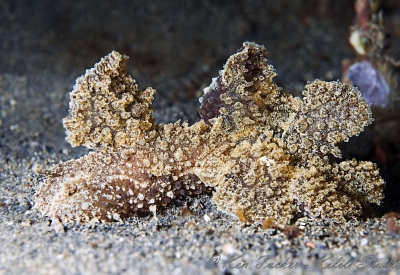
Note added 22 October 2008: This animal, previously identified on the Forum as Melibe mirifica, is almost certainly not that species, which I now consider to be a synonym of M. japonica. See message [#21985].
Note added 24 October 2008: It is most probably a colour form of M. viridis - see message [#21988]
Dear Bill,
A very nice specimen of Melibe mirifica, I think.
Locality: Lembeh Strait - Hairball, 10 metres, Indonesia, Sulawesi, 21 Nov 2006. Length: 18 cm. Photographer: Ken Tucker.
Ken Tucker
ken@kilili.com
Tucker, K., 2007 (Jun 18) Melibe mirifica from Sulawesi. [Message in] Sea Slug Forum. Australian Museum, Sydney. Available from http://www.seaslugforum.net/find/19393Thanks Ken,
Best wishes,
Bill Rudman
Melibe viridis from Davao Gulf
May 25, 2007
From: Carlos R. Munda
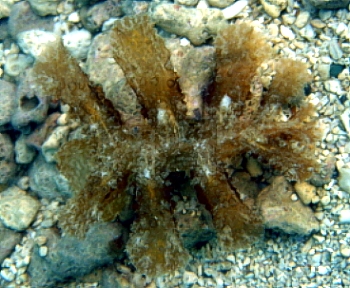
Here are some photos of Melibe fimbriata for your file.
Locality: Samal island, 15-20 feet, Philippines, Davao gulf , December 2006, sandy. Length: 2-3 inches. Photographer: Carlos R. Munda, jr..
Carlos R. Munda
c_munda@yahoo.com
Munda, C., 2007 (May 25) Melibe viridis from Davao Gulf. [Message in] Sea Slug Forum. Australian Museum, Sydney. Available from http://www.seaslugforum.net/find/19192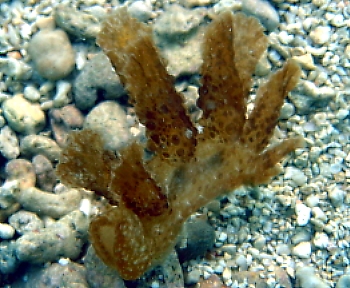
Dear Carlos,
There is still some confusion over these large species of Melibe from the Indian and Pacific Oceans. On the Forum I am using Melibe fimbriata only as a 'convenience' name for the large Melibe which has moved through the Suez Canal from the Red Sea into the Mediterranean. I suspect it is, like your animal, Melibe viridis.
I may be wrong, but whatever the case, it is very difficult from photos to distinguish the external differences, which have been used to characterise some species in this genus.
Best wishes,
Bill Rudman
Sweet-smelling Melibe from South Korea
November 7, 2006
From: Grace N. Palmos
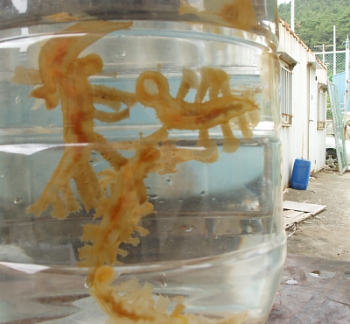
Dear Dr. Bill and all,
Greeting from South Korea!
I am a student and I had been browsing the forum for quite some time now finding the information generously shared by the members very helpful. It is only now that I have the confidence to share the little information I gathered from observing this species of sea slugs. However, I need assistance in correctly identifying this species because there is no taxonomist or for that matter there's nobody from the university who studies this species. So attached are some pictures and I hope the members can comment on them.
Locality: Suwoli Pearl Farm , ca 5 m, Tongyeong (Chungmu; 128°07'~128°44' east, and 34°30'~34°58' north) City, South Korea , Tongyeong Sea , 23 August 2006, Aquarium. Length: ca 7 cm. Photographer: Grazia.
Initially, we identified them as Melibe pilosa (or is it papillosa?). We obtained these slugs from a pearl oyster culture farm in the Tongyeong Sea. Local workers told us that they are often spotted during the summer season clinging to the culture baskets (which are suspended approximately 5 meters below sea water). The average length (as of August this year) of the slugs ranges from 2 - 7 centimeters. They are transparent, often cream to orange in color and some pale brown spots all over their body. Like other species of Melibe, they have a quite large oral hood which systematically opens and closes to draw in their food. They swim by vigorously bending their body from side to side (lateral) with their "head" oftentimes touching their "tail".
The first picture shows a couple of Melibe which I think were mating at that time, as well as exhibiting the "tailing" behavior. This species also emits a citrus-like odor when disturbed. Actually, it is quite a pleasant odor.
Thank you very much for posting my message and any comments/suggestions will be taken positively.
More power,
Grazia
grace_palmos@yahoo.com


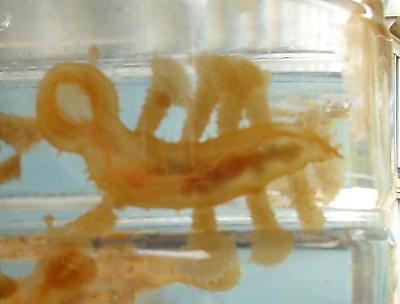
Dear Grazia,
I am inclined to call this Melibe viridis, but as you will see in earlier discussions, it is not always easy at present to distinguish the various species of Melibe that have been described.
Your mention of the sweet smell your animals produce is very interesting as a similar odour has been reported from M. leonina and M. australis [see message #16667]. I suggest there that the aldehyde molecule involved may be produced by other members of the genus as well, and your report certainly adds weight to that prediction.
Don't feel hesitant in sharing your observations. In many ways we are all novices in understanding the biology and natural history of these animals, so all contributions are valubale and welcome
Best wishes,
Bill Rudman
Melibe viridis in East Timor
November 2, 2006
From: Brian Francisco

Hi Bill
We found two distinct species of Melibe this morning, including three individuals that I believe to be Melibe viridis. Although we have seen relatively small species of Melibe in the past (perhaps juvenile viridis), this is our first encounter with the larger Melibe. While we observed, one of the individuals caught and ate a small crab. It seemed to take about 10 seconds for the Melibe to work the live crab into its 'mouth' before continuing its hunt.
Locality: Tasi Tolu, 15 meters, East Timor, Banda Sea, 13 August 2006, Sandy Slope. Length: 10-12cm. Photographer: Brian Francisco.
Just a few weeks ago I commented somewhat sympathetically on sea slugs' incredible ability to endure the stinging, biting, and otherwise annoying microscopic 'wildlife' they encounter. But these Melibe seem more like formidable predators, unlikely to be deterred by a pesky syllid.
Cheers
Brian
www.uwet.net
UnderWater East Timor
uwet.blogspot@gmail.com
Francisco, B., 2006 (Nov 2) Melibe viridis in East Timor. [Message in] Sea Slug Forum. Australian Museum, Sydney. Available from http://www.seaslugforum.net/find/17451Dear Brian,
It's a bit hard to separate some of the 'species' of Melibe, especially from photos, but I would agree that your animals are most likely to be Melibe viridis. They are indeed very efficient predators - fortunately for small crustacea they only seem to occur in large groups on rare occasions.
Best wishes,
Bill Rudman
Melibe viridis from Buton Island, Banda Sea
December 3, 2005
From: Linda Ianniello
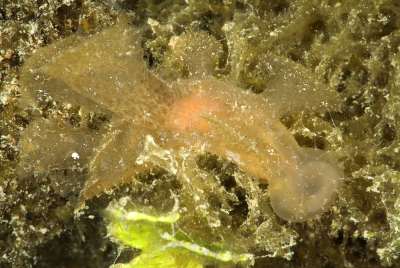
Dr. Bill,
there aren't many shots of Melibe viridis on the Forum. Here is a well-camouflaged one found a on a night dive.
Locality: Buton Island, Buton Beach, Indonesia, Banda Sea. Depth: 15 feet. 3 November 2005. Sandy, rubble. Photographer: Linda Ianniello
Regards,
Linda I.
lindai1@bellsouth.net
Ianniello, L., 2005 (Dec 3) Melibe viridis from Buton Island, Banda Sea. [Message in] Sea Slug Forum. Australian Museum, Sydney. Available from http://www.seaslugforum.net/find/15360Thanks Linda,
Bill Rudman
Melibe from the Gulf of Kutch, India
July 1, 2005
From: Arpit Deomurari

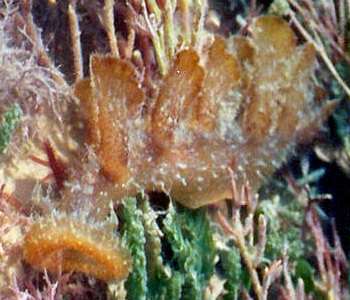
Respected Sir
I'm an amateur marine biologist from Gujarat, India. We have a marine national park in the Gulf of Kutch. This April I came across two different species of sea slug which I think are not recorded from this region. The one of which pictures are given here is very strange looking slug. I had checked all the referance of sea slug from this area but i haven't found any reference close to this species. Please help me to identify this species. I have also doubt that it could not be opisthobranch too... but in India there are very limited resources available to study them...
Remarks:
1. Total 3 individuals found in around 1 Sq KM
2. They were found feeding on algae with it's mouth by expanding and grasping the algae in it's mouth like structure.
Locality: Bay of Poshitra, (24.77.46 N, 52.07.77 E). near Okha, Gujarat. India Gulf of Kutch, Arabian Sea. Depth: shallow water coral reef . Length: 20 cm. April 2005. coral reef with algae bloom. Photographer: Arpit Deomurari
Arpit Deomurari
arpit@kutchabhiyan.net
Deomurari, A.N., 2005 (Jul 1) Melibe from the Gulf of Kutch, India. [Message in] Sea Slug Forum. Australian Museum, Sydney. Available from http://www.seaslugforum.net/find/14130
Dear Arpit,
This is Melibe viridis, a species of the strange and spectacular nudibranch genus Melibe. In fact I spent 2 months in 1971 in the Gulf of Kutch collecting nudibranchs and one of the animals I was looking for was Melibe because it had been reported from Okha and I was keen to see it. I didn't know then but it was the wrong time of year, but the staff of the marine station at Okha were very helpful. The expedition to find Melibe involved a rather hair-raising journey in a small dhow and then an hours walk in about 40 C heat across an island and then what seemed like an endless search in knee deep mud without success. A few days later some helpful technicians at the marine station found 4 animals at nearby Balapur [11 June 1971 - 8cm long] - just as in your photos. Unfortunately I had run out of film so was unable to photograph them. So now, 35 years later, I have a photo of the Melibe from Okha.
I have listed below one reference to the opisthobranch fauna of the Gulf of Kutch, which I guess you are familar with, but I am sure there is another which mentions finding Melibe. Unfortunately I can't find it, but if I do I'll let you know.
I see Pirotan Island is now a marine park with accomodation. There was no accomodation when I was there, and one of my strongest memories of the island was sleeping in an old fishing boat and waking in the morning to find that rats had been crawling over me and my wife during the night to feast on a watermelon we had brought with us for food. As my wife said - amongst other things - "You have to be crazy to study slugs"
-
Narayanan, K. R. (1969) On the opisthobranchiate fauna of the Gulf of Kutch. Proceedings of the Symposium on Mollusca held at Cochin from January 12 to 16, 1968, Symposium Series 3, Pt. 1, Marine Biological Association of India, Mandapam Camp, India: 188-213. Figs 1-20.
Best wishes,
Bill Rudman
Melibe from the Mediterranean
March 3, 2005
From: Katerina Tzouvali & Dimitris Pettas

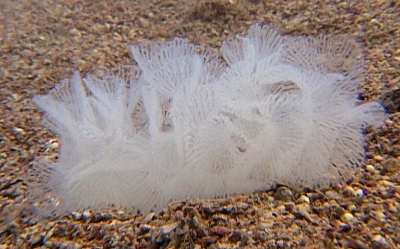
Dear Dr Rudman
We are underwater videographers and we would like to have your help for the indentification of a sea slug. We think that it is Melibe viridis. We saw two individuals, one was about 150 mm and the other one was about 100 mm. We also found and egg ribbons at the same area, which we suppose that belong to the same animal.
Locality: Panagopoula, near Patras, West Greece, Mediterranean Sea. Depth: 7 meters. Length: 150 mm. 8 October 2004. Sandy bottom. Photographer: K. Tzouvali and D.Pettas
We would be very grateful if you could help us.
Sincerely
K Tzouvali, D. Pettas
Seawatch Undrwater video, Environmental documentary
seawatch@mes.forthnet.gr
Tzouval, K. & Pettas, D., 2005 (Mar 3) Melibe from the Mediterranean. [Message in] Sea Slug Forum. Australian Museum, Sydney. Available from http://www.seaslugforum.net/find/13244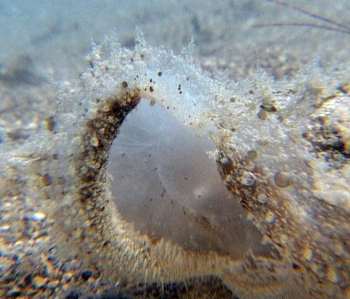
Dear Katerina and Dimitris,
I can never see too many photos of, or living, Melibe. It always strikes me as an almost unbelievable shape, with its large 'fishing net' head. As I have said in other messages, I am not sure just how many species of Melibe occur in the Indian Ocean species, but Melibe viridis is probably the best name to use at present. It is apparently an immigrant to the Mediterranean from the Red Sea. [see page on lessepsian migration].
Best wishes,
Bill Rudman
Melibe mirifica from Indoneisa
March 19, 2004
From: Patricia Danna
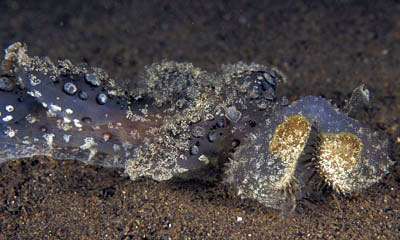
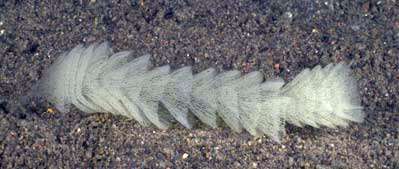
Note added 22 October 2008: This animal, previously identified on the Forum as Melibe mirifica, is almost certainly not that species, which I now consider to be a synonym of M. japonica. See message [#21985].
Note added 24 October 2008: It is most probably a colour form of M. viridis - see message [#21988]
Dear Bill
I'd be most grateful if you could help me identify the species of this Melibe.
Could these eggs be from the Melibe?
Photos: Bali, Indonesia. Depth 7m. Length:15 to 20 cm. November 2003. [#c28]
Patricia Danna
tdmpat@chez.com
Danna, P., 2004 (Mar 19) Melibe mirifica from Indoneisa. [Message in] Sea Slug Forum. Australian Museum, Sydney. Available from http://www.seaslugforum.net/find/12461Dear Patricia,
From the shape and colour of the cerata I would say this is Melibe mirifica. I am not sure whether the oral veil is damaged, but it certainly looks a bit peculiar. Concerning the possible egg ribbon. It certainly looks like it could be the egg ribbon of a Melibe if you compare it with an earlier message on the egg ribbon of Melibe engeli [#9356] In that message I suggested that the spiral was a second example of a species of Melibe with dextral spiralling of the egg ribbon [clockwise from the centre]. Your egg ribbon certainly coils the same way as M. engeli but I am not sure whether this can be considered clockwise [dextral] or anticlockwise [sinistral] as I don't know where the ribbon starts and ends. Did the animal produce the anchoring thread first and then produced the coil, or did it first produce the long coil abd then anchor it in the sand? If the anchor came first then the spiral is anticlockwise, but if the anchor was produced last then the coiling is clockwise. It is interesting that Hydatina physis another sand-dwelling opisthobranch appears to produce its egg ribbon and carry it around until its is all laid before anchoring it in the sand [see message #12032]. This suggests that the idea of Melibe producing the long ribbon before anchoring it is a reasonable suggestion. It will be interesting to see if anyone has any photos or observations to clarify the situation.
Best wishes
Bill Rudman
Melibe viridis ? from the Philippines
December 18, 2003
From: Erwin Köhler
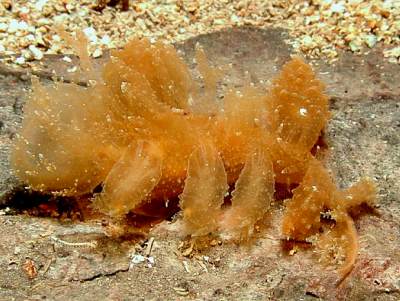
Dear Bill,
Attached is a shot of what I think to be Melibe viridis from the Philippines, Negros Oriental Is., Lipayo, divesite "Dauin Sanctuary 1".
In your Fact sheet you write Kelaart placed it in the genus Meliboea, so the name of the author and the year should be in brackets.
data:
length 75mm
depth 14m
date 25 Oct. 2003
Regards,
Erwin
Erwin@Philippine-Sea-Slugs.com
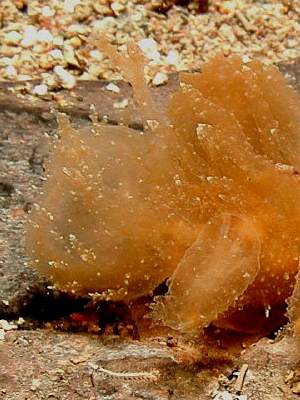

Thanks Erwin,
As I have mentioned before, the identity of some of these species is quite difficult, but I guess M. viridis is the best name for this animal at present. However it seems the rhinophore stalk has a large branch, and the papillae on the back are very large, so it may be another species.
Concerning your comment about Kelaart's use of the name Meliboea instead of Melibe. You are quite correct in suggesting that if Kelaart described the species in a different genus than the one it is now placed in [ie: Meliboea not Melibe] then Kelaart's name and date should be in brackets. However Kelaart was just using a mispelling of Melibe - Meliboea - which was quite commonly used at the time
Henning Lemche (1962) in a submission to the International Commission on Zoological Nomenclature, concerning the name Doto, noted that Forbes 1838 described a species of Doto as Melibaea fragilis. The genus name was often mispelt, even by Forbes in the same publication, as Meliboea. Lemche noted that these were mispellings of Melibe Rang 1829 and proposed that Meliboea Forbes 1838 and Melibaea Forbes 1838 be placed on the Offical Index of Rejected Names. The International Commission accepted this proposal two years later (I.C.Z.N. 1964 -Opinion 697). Basically these 2 spellings have no status in zoological nomenclature so we act as though Kelaart spelt the genus name as Melibe and therefore don't use brackets.
• Forbes, Edward. 1838. Malacologia monensis, a catalogue of the Mollusca inhabiting the Isle of Man and the neighboring sea. pp. i-xii + 1-63, pls. 1-3. [Nudibranchia pp. 3-5, 59, pl. 1].
• I.C.Z.N. 1964. Opinion 697. Doto Oken, 1815 (Gastropoda): validated under the plenary powers. Bulletin of Zoological Nomenclature, 21(2): 97-100.
• Lemche, H. M. 1962. Doto Oken, 1815 (Gastropoda): proposed validation under the plenary powers. Z.N.(S.) 1006. Bulletin of Zoological Nomenclature, 19: 156-159.
Best wishes,
Bill Rudman
Melibe? from Japan
July 29, 2001
From: John Perry
I'm an assistant instructor at a local dive shop in Fukuoka, Japan. Last Sunday I went diving and saw a nudibranch that I had never seen before and I was hoping that I could get some assistance in finding out what it was.
It looked like a cross between a Melibe leonina and an Aplysia parvula. It was laterally compressed and its head seemed to have a hood like Melibe leonina but it was kelp green in colour. It was about 10 cm long and when lifted up it wriggled and danced like a Spanish Dancer.
Sorry I can't be a little more specific but any help you could provide would be great.
Thanks,
John Perry
jperry@fat.coara.or.jp
Perry, J., 2001 (Jul 29) Melibe? from Japan. [Message in] Sea Slug Forum. Australian Museum, Sydney. Available from http://www.seaslugforum.net/find/4907Dear John,
I could well be a species of Melibe as they are not uncommon in the western Pacific and can swim by lateral body waves. Have a look at the pages on Melibe engeli, Melibe mirifica and Melibe viridis. It is most likely to be M. viridis. The names of the large Indo-west Pacific species of Melibe, and in fact the number of species, is still in the melting pot, so you will find various names used in different books.
On the off-chance you have a swimming Aplysia have a look at the Sea Hare Page for a list of pages to look at.
Best wishes,
Bill Rudman
Melibe mirifica from Papua New Guinea
September 21, 2000
From: Mary Jane Adams

Note added 22 October 2008: This animal, previously identified on the Forum as Melibe mirifica, is almost certainly not that species, which I now consider to be a synonym of M. japonica. See message [#21985].
Note added 24 October 2008: It is most probably a colour form of M. viridis - see message [#21988]
Hi Bill,
I encountered this Melibe on a night dive at Bunama Mission, Normanby Island, Papua New Guinea. This is the same divesite where I found the Kalinga ornata a year earlier. It was one of a pair that were slurping their way across a sandy bottom. The larger one was about 25 cm crawling length and the smaller one, pictured here, about 15 cm. It was quite a photographic challenge to depict a mostly colorless animal covered with sand on a sandy background at night! Can you see enough detail to ID this species? What do you think the mid body yellow patch is in the upper photo?
Depth: 5 meters March 11, 1999
Thanks!
Mary Jane
mjadams@earthlink.net
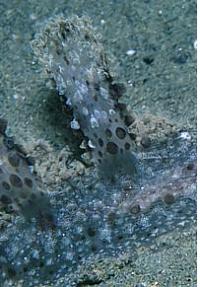

Dear Mary Jane,
Your photos are more than clear enough to identify this species as Melibe mirifica. One distinguishing feature of the species are the conical papillae all over without branching filaments.
At first I thought the yellow patch you mention was the site of a lost ceras, which they quite often drop off, but it doesn't seem to be missing any. About that level of the body sit the glands of the reproductive system so it is possibly an ovary or gland of the reproductive system showing through the almost transparent body wall.
Best wishes,
Bill Rudman.
A Melibe? from Papua New Guinea
January 7, 1999
From: Alan M. Grant
A friend of mine has been diving in the Milne Bay area of PNG. He videotaped what appears to be a large (10-15 cm.) nudibranch on a sand/mud bottom, with morphology similar to Melibe leonina, but not as translucent and generally a light sandy brown color. Any ideas without seeing a picture?
Alan Grant
Laguna Beach,
California,
USA.
dentadiv@fea.net
Grant, A.M., 1999 (Jan 7) A Melibe? from Papua New Guinea. [Message in] Sea Slug Forum. Australian Museum, Sydney. Available from http://www.seaslugforum.net/find/447Dear Alan,
If it looks like Melibe leonina then it almost certainly is a Melibe as there is no other genus of nudibranchs which looks quite like Melibe. Melibe leonina, from the West Coast of North America, is normally found living on giant kelp plants where it uses its remarkable oral veil/hood as a net to catch crustacea. Most other species are benthic dwellers, but they all have the amazing oral veil. I suspect the species you describe is Melibe viridis [see top of page] but I would need a photo to be sure.
Bill Rudman.
